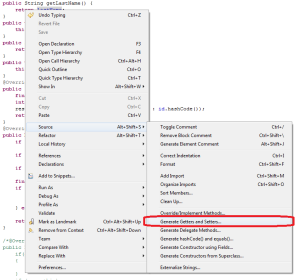[转]Java 中正确使用 hashCode 和 equals 方法
Contents
在这篇文章中,我将告诉大家我对hashCode和equals方法的理解。我将讨论他们的默认实现,以及如何正确的重写他们。我也将使用Apache Commons提供的工具包做一个实现。 目录:
- hashCode()和equals()的用法
- 重写默认实现
- 使用Apache Commons Lang包重写hashCode()和equals()
- 需要注意记住的事情
- 当使用ORM的时候特别要注意的
使用hashCode()和equals()
hashCode()方法被用来获取给定对象的唯一整数。这个整数被用来确定对象被存储在HashTable类似的结构中的位置。默认的,Object类的hashCode()方法返回这个对象存储的内存地址的编号
重写默认的实现
如果你不重写这两个方法,将几乎不遇到任何问题,但是有的时候程序要求我们必须改变一些对象的默认实现。
来看看这个例子,让我们创建一个简单的类Employee
public class Employee
{
private Integer id;
private String firstname;
private String lastName;
private String department;
public Integer getId() {
return id;
}
public void setId(Integer id) {
this.id = id;
}
public String getFirstname() {
return firstname;
}
public void setFirstname(String firstname) {
this.firstname = firstname;
}
public String getLastName() {
return lastName;
}
public void setLastName(String lastName) {
this.lastName = lastName;
}
public String getDepartment() {
return department;
}
public void setDepartment(String department) {
this.department = department;
}
}
上面的Employee类只是有一些非常基础的属性和getter、setter.现在来考虑一个你需要比较两个employee的情形。
public class EqualsTest {
public static void main(String[] args) {
Employee e1 = new Employee();
Employee e2 = new Employee();
e1.setId(100);
e2.setId(100);
//Prints false in console
System.out.println(e1.equals(e2));
}
}
毫无疑问,上面的程序将输出false,但是,事实上上面两个对象代表的是通过一个employee。真正的商业逻辑希望我们返回true。 为了达到这个目的,我们需要重写equals方法。
public boolean equals(Object o) {
if(o == null)
{
return false;
}
if (o == this)
{
return true;
}
if (getClass() != o.getClass())
{
return false;
}
Employee e = (Employee) o;
return (this.getId() == e.getId());
}
在上面的类中添加这个方法,EauqlsTest将会输出true。 So are we done?没有,让我们换一种测试方法来看看。
import java.util.HashSet;
import java.util.Set;
public class EqualsTest
{
public static void main(String[] args)
{
Employee e1 = new Employee();
Employee e2 = new Employee();
e1.setId(100);
e2.setId(100);
//Prints 'true'
System.out.println(e1.equals(e2));
Set<Employee> employees = new HashSet<Employee>();
employees.add(e1);
employees.add(e2);
//Prints two objects
System.out.println(employees);
}
上面的程序输出的结果是两个。如果两个employee对象equals返回true,Set中应该只存储一个对象才对,问题在哪里呢? 我们忘掉了第二个重要的方法hashCode()。就像JDK的Javadoc中所说的一样,如果重写equals()方法必须要重写hashCode()方法。我们加上下面这个方法,程序将执行正确
@Override
public int hashCode()
{
final int PRIME = 31;
int result = 1;
result = PRIME * result + getId();
return result;
}
使用Apache Commons Lang包重写hashCode() 和equals()方法
Apache Commons 包提供了两个非常优秀的类来生成hashCode()和equals()方法。看下面的程序。
import org.apache.commons.lang3.builder.EqualsBuilder;
import org.apache.commons.lang3.builder.HashCodeBuilder;
public class Employee {
private Integer id;
private String firstname;
private String lastName;
private String department;
public Integer getId() {
return id;
}
public void setId(Integer id) {
this.id = id;
}
public String getFirstname() {
return firstname;
}
public void setFirstname(String firstname) {
this.firstname = firstname;
}
public String getLastName() {
return lastName;
}
public void setLastName(String lastName) {
this.lastName = lastName;
}
public String getDepartment() {
return department;
}
public void setDepartment(String department) {
this.department = department;
}
@Override
public int hashCode() {
final int PRIME = 31;
return new HashCodeBuilder(getId() % 2 == 0 ? getId() + 1 : getId(), PRIME).
toHashCode();
}
@Override
public boolean equals(Object o) {
if (o == null)
return false;
if (o == this)
return true;
if (o.getClass() != getClass())
return false;
Employee e = (Employee) o;
return new EqualsBuilder().
append(getId(), e.getId()).
isEquals();
}
}
如果你使用Eclipse或者其他的IDE,IDE也可能会提供生成良好的hashCode()方法和equals()方法。

需要注意记住的事情
尽量保证使用对象的同一个属性来生成hashCode()和equals()两个方法。在我们的案例中,我们使用员工id。
eqauls方法必须保证一致(如果对象没有被修改,equals应该返回相同的值)
任何时候只要a.equals(b),那么a.hashCode()必须和b.hashCode()相等。
两者必须同时重写。
当使用ORM的时候特别要注意的
如果你使用ORM处理一些对象的话,你要确保在hashCode()和equals()对象中使用getter和setter而不是直接引用成员变量。因为在ORM中有的时候成员变量会被延时加载,这些变量只有当getter方法被调用的时候才真正可用。
例如在我们的例子中,如果我们使用e1.id == e2.id则可能会出现这个问题,但是我们使用e1.getId() == e2.getId()就不会出现这个问题。
希望这篇文章能够帮助你。
自己总结
hashCode() 方法, 表示该对象在Map中的索引值.
equals() 方法, 表示在对象在Map中的hashCode()对应索引位置的对象是否相等.
